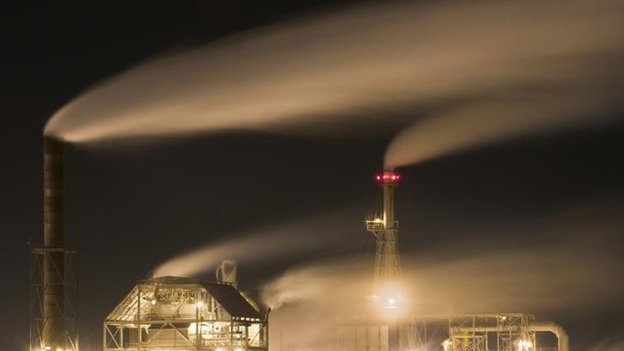
The Obama administration has released strong new rules targeting coal-burning power plants in an effort to curb global warming.
The Environmental Protection Agency's (EPA) Clean Power Plan seeks to cut carbon emissions by 30% by 2030.
The Obama administration has released strong new rules targeting coal-burning power plants in an effort to curb global warming.
The Environmental Protection Agency's (EPA) Clean Power Plan seeks to cut carbon emissions by 30% by 2030.
The 645-page rule is a centrepiece of President Barack Obama's plans to leverage similar commitments other polluting nations like China and India.
States must submit initial compliance plans by June 2016.
"We are here to protect public health and the environment," EPA Administrator Gina McCarthy said on Monday, arguing climate change was "supercharging" risks to health, communities and the economy.
"This was the preferred path forward," she added. "Climate inaction is costing us more money in more places, more often."

The rules seek to reduce carbon emissions by 30% below 2005 levels, which the EPA says is equal to the emissions from powering more than half the homes in the US for one year.
Particle pollution, sulphur dioxide and nitrogen oxides may also be reduced by more than 25% as a co-benefit, the EPA wrote.
Critics have argued the new US rules will cause power plants to close and electricity prices to rise.
"Miners are losing their jobs, families are struggling to make ends meet and there is no relief in sight from the heavy hand of Obama's EPA," Republican Congresswoman Shelley Moore Capito wrote in a statement.
But the EPA estimates the new rules will shrink electricity bills by 8% by increasing energy efficiency and reducing demand on the electricity system.
"They're wrong," Ms McCarthy said. "We have never, nor will we ever, have to choose between a healthy economy and a healthy environment."
Administration officials have described the new rules as a step toward achieving a pledge Mr Obama made in his first year in office to make sizeable cuts in US carbon emissions by 2020.

The Democratic president has been unable to persuade Republicans in Congress to act on climate change legislation.
A 2010 Democratic effort to pass a bill limiting carbon-dioxide emissions and allowing companies to buy and sell permits to pollute was blocked by Senate Republicans.
Now, the Obama administration is relying on a 2007 US Supreme Court ruling that gave the Environmental Protection Agency, part of the executive branch of the US government under Mr Obama's control, the ability to regulate carbon dioxide under the Clean Air Act.
The new rules are expected to be finalised in June 2015 after a period of public comment.
States are then required to submit initial plans for compliance to the EPA by June 2016. They can petition for additional time - up to June 2018 - should it be required.
Strategies for state compliance may include increasing nuclear or solar power, switching to natural gas, or moving towards an emissions-trading plan known as cap-and-trade.

Are you in the US? What is your reaction to the new climate change guidelines? You can send us your comments by emailinghaveyoursay@bbc.co.uk using the subject line "Climate"

 Previous page
Previous page Back to top
Back to top







